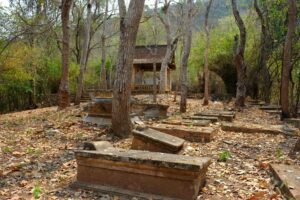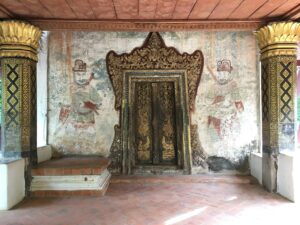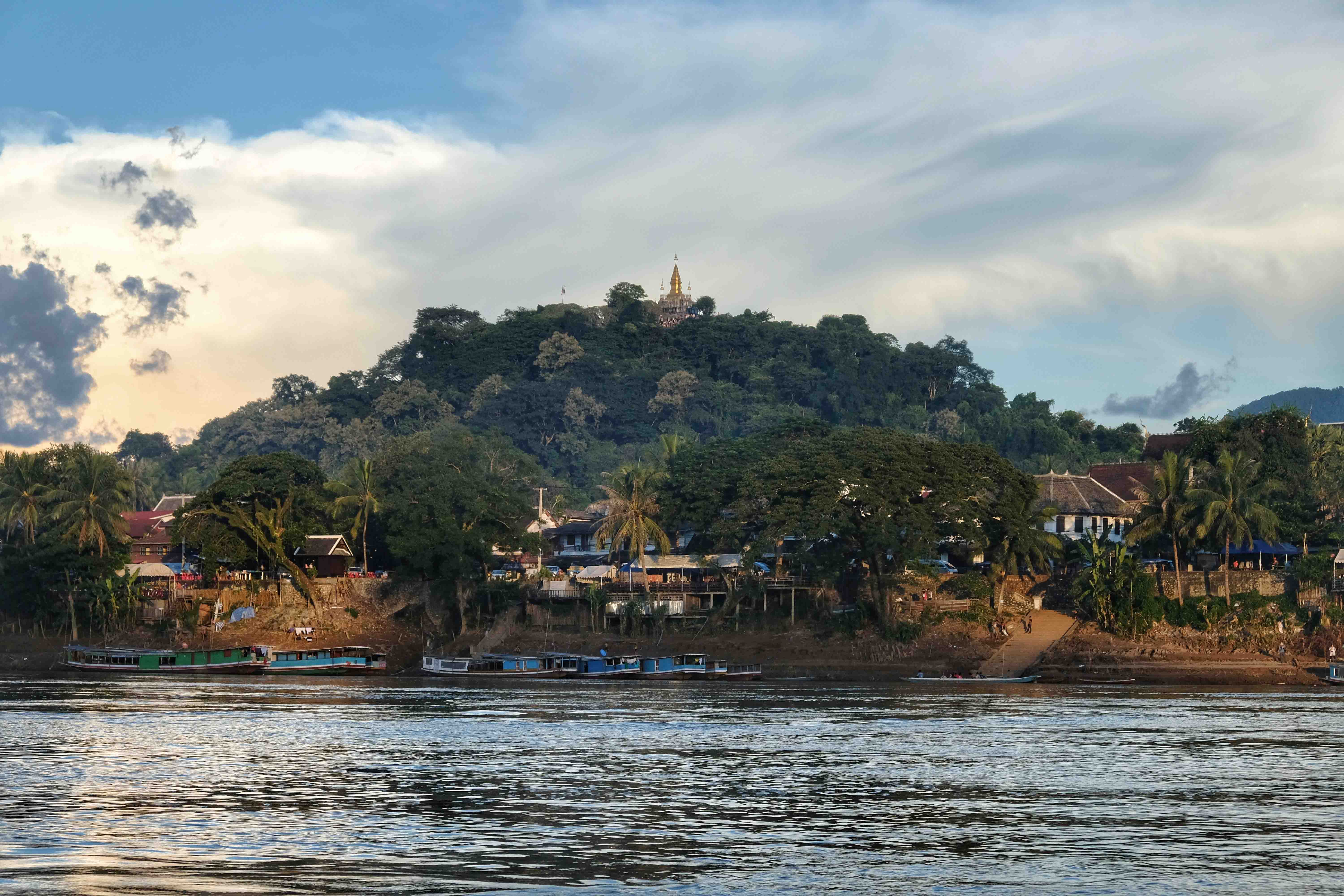ອີກຟາກຝັ່ງຂອງແມ່ນໍ້າຂອງອັນໜ້າຫຼົງໄຫຼ
ທ່ານກຳລັງຊອກຫາວັນພັກຜ່ອນທີ່ດີທີ່ສຸດຢູ່ແມ່ນບໍ່? ຕະຫຼອດເສັ້ນທາງກົງກັນຂ້າມກັບເມືອງຫຼວງພະບາງຈະເຫັນບ້ານ ຊຽງແມນ ແລະ ເມືອງຈອມເພັດ. ບັນດານັກທ່ອງທ່ຽວຈຳນວນໜຶ່ງກໍ່ພາກັນເບິ່ງຂ້າມເຂດນີ້ທີ່ມີສະເໜ່ ແລະ ເຕັມໄປດ້ວຍເລື່ອງລາວປະຫວັດສາດອັນໜ້າປະທັບໃຈທີ່ລໍຖ້າໃຫ້ທ່ານອອກໄປສໍາຜັດດ້ວຍໂຕຂອງທ່ານເອງ.
ໃນການເດີນທາງໄປເມືອງຈອມເພັດ, ທ່ານສາມາດຂີ່ເຮືອຍາວເລາະເຊິ່ງຈອດລໍຖ້າທາງດ້ານຫຼັງຂອງພະລາຊະວັງເກົ່າ. ການເດີນທາງແມ່ນຈະໃຊ້ເວລາປະມານ 5 ນາທີເທົ່ານັ້ນ. ຢູ່ຝາກກົງກັນຂ້າມຂອງຝັ່ງ, ທ່ານຈະເຫັນບັນດາຮ້ານຂາຍເຄື່ອງຈຳນວນຫຼາຍຢັງຢາຍກັນຢູ່ຕາມແຄມຝັ່ງ ເຊິ່ງສິ່ງທີ່ເຮົາຈະເຫັນໄດ້ຢ່າງໂດດເດັ່ນເລີຍກໍ່ແມ່ນໝໍ້ຮ້ອນໜ່ວຍໃຫຍ່ທີ່ກຳລັງອຸ່ນໄຂ່ ແລະ ມີອາຍຄວັນລອຍກຸ້ມຂຶ້ນ, ປີ້ງປາເອືອບເກືອ ບວກກັບກິ່ນຫອມໆຂອງຫົວສີໄຄອ່ອນ ແລະ ໄສ້ອົ່ວສົ້ມແຊບໆ. ຖ້າທ່ານໄປຮອດຕອນເຊົ້າ ທ່ານອາດຈະເຫັນຄູບາອອກບິນທະບາດ ລຽງເປັນແຖວຍາວ.
ຫຼຽວໄປທາງຊ້າຍມືຂຶ້ນເມືອທາງໃຕ້ ໄປທີ່ ບ້ານຈັນເໜືອ, ເຮົາຈະເຫັນໝູ່ບ້ານປັ້ນດິນເຜົາ. ໝູ່ບ້ານແຫ່ງນີ້ ຖືເປັນໝູ່ບ້ານທີ່ຂຶ້ນຊື່ເລື່ອງການປັ້ນໝໍ້ຫຼໍ່ໄຫ ມາເປັນເວລາຫຼາຍກວ່າ 400 ປີ. ກ້ອນດິນໜຽວໃຫຍ່ໆໄດ້ຖືກນຳມາຜະລິດແປຮູບ ໂດຍການນຳໃຊ້ເຕັກນິກແບບພື້ນເມືອງ. ຂະບວນການຜະລິດດັ່ງກ່າວ ແມ່ນເມີສະເໜ່ແທ້ໆ ໂດຍສະເພາະເວລາທີ່ເຮົາເບິ່ງມືທີ່ກໍາລັງຫຼອມດິນປັ້ນໃຫ້ເປັນລັກສະນະຕ່າງໆ ເລີ່ມຈາກການຫຼອມໃຫ້ເປັນວົງກົມນ້ອຍໆ ແລ້ວມັນກາຍເປັນຖ້ວຍ, ຈອກ ແລະ ໂຄມໄຟ, ຜະລິດຕະພັນສີໄມ້ລາຍມືທີ່ຜະລິດຢູ່ສະຖານທີ່ແຫ່ງນີ້ ສາມາດເຫັນໄດ້ຢູ່ເກືອບທົ່ວທຸກບ່ອນຂອງແຂວງ. ຖືເປັນສະຖານທີ່ ທີ່ເໝາະສົມທີ່ີສຸດສໍາລັບໃຜທີ່ກໍາລັງຊອກຫາຂອງຝາກຕິດໄມ້ຕິດມືກັບບ້ານ!
ເມື່ອຂີ່ຍ້ອນກັບໄປທີ່ທ່າເຮືອ, ທ່ານຈະພົບກັບສຸສານຂອງອະດີດເຈົ້າຊີວິດ, ບໍ່ແມ່ນເລື່ອງງ່າຍເລີຍທີ່ຈະຊອກຫາຂໍ້ມູນກ່ຽວກັບປະຫວັດຄວາມເປັນມາຂອງສະຖານທີ່ແຫ່ງນີ້ໄດ້ຢ່າງລະອຽດ ແລະ ເສັ້ນທາງໄປຍັງບ່ອນດັ່ງກ່າວກໍ່ຄ່ອນຂ້າງຫຍຸ້ງຍາກ. ເສັ້ນທາງນີ້ ຍັງນຳໄປສູ່ອະນຸສາວະລີຫີນສີຂາວ ເຊິ່ງເປັນບ່ອນປະທັບສົບຂອງລາຊິນີອົງກ່ອນ. ໝາກເບັງ ແລະ ດອກດາວເຮືອງ ທີ່ຖືກວາງໄວ້ຢູ່ເທິງຫຼຸມຝັງສົບ ບົ່ງບອກໃຫ້ຮູ້ວ່າບ່ອນດັ່ງກ່າວຍັງເປັນທີ່ເຄົາລົບນັບຖືຂອງປະຊາຊົນແຖບນັ້ນຢູ່. ເລາະລຽບໄປຕາມຕີນພູ ເຮົາກໍ່ຍັງຈະເຫັນຫຼຸມຝັງສົບໃນສະໄໝກ່ອນຈຳນວນໜຶ່ງ. ຫຼຸມຝັງສົບເຫຼົ່ານັ້ນແມ່ນຂ້ອນຂ້າງນ້ອຍ, ເຊິ່ງເຊື່ອກັນວ່າອາດເປັນຫຼຸມຝັງສົບຂອງເຈົ້າຊາຍ ແລະ ເຈົ້າຍິງໃນສະໄໝນັ້ນ ທີ່ເສຍຊີວິດໃນອຸບັດເຫດເຮືອຫຼົ້ມ ຢູ່ແມ່ນໍ້າຂອງ ໃນຊຸມປີ 1931.

ລະຫວ່າງທາງກັບທ່ານສາມາດມາແວ່ຢ້ຽມຢາມ ບ້ານ ຊຽງແມນ່ ທີ່ຂະໜາບເສັ້ນທາງສາຍເໜືອສູ່ທ່ານເຮືອທັງສອງຂ້າງ. ບັນດາວັດວາອາຮາມທີ່ຕັ້ງຢູ່ຕາມສາຍທາງນີ້ ແມ່ນມີສາຍກ່ຽວພັນອັນສຳຄັນ ທີ່ເຊື່ອມໂຍງກັບປະຫວັດສາດຂອງ ຫຼວງພະບາງ. ວັດແຫ່ງທຳອິດ ທີ່ພວກເຮົາມາຮອດ ແມ່ນວັດຊຽງແມນ ເຊິ່ງຖືກສ້າງຕັ້ງຂຶ້ນໃນປີ 1592 ໃນສະໄໝເຈົ້າໄຊເສດຖາທິລາດ. ວັດແຫ່ງນີ້ ແມ່ນບ່ອນທີ່ ພະບາງ, ໄດ້ຖືກນຳມາພັກໄວ້ ເປັນເວລາ 7 ວັນ ໃນໄລຍະທີ່ຖືກນໍາກັບມາຈາກປະເທດໄທເພື່ອປະດິດສະຖານທີ່ຫຼວງພະບາງ. ວັດຈອມເພັດ ແມ່ນຢູ່ຖັດໄປ ແລະ ຕ້ອງຂຶ້ນຂັ້ນໄດ123 ຂັ້ນ ຈຶ່ງຂຶ້ນໄປຮອດ. ວິວທິວທັດທີ່ແນມລົງມາຈາກດ້ານເທິງນັ້ນ ແມ່ນເປັນຕາໜ້າອັດສະຈັນຫຼາຍ, ເຊິ່ງທ່ານຈະເຫັນ ໝອກຂາວປົກຄຸມທຳມະຊາດສີຂຽວອຸ່ມທຸ່ມ ແລະ ທິວທັດເບື້ອງຫຼັງພູກໍເປັນສີຟ້າຄາມງາມເປັນຕາສະອອນແທ້ໆ.

ເສັ້ນທາງຕໍ່ຈາກນັ້ນ ກໍ່ແມ່ນເຂດວັດ ລ່ອງຄູນ. ວັດດັ່ງກ່າວ ແມ່ນເຕັມໄປດ້ວຍເລື່ອງລາວອັນໜ້າປະທັບໃຈທີ່ໄດ້ມີການແຕ້ມໄວ້ຕາມຝາທາງເຂົ້າ. ທາງຂ້າງປະຕູທັງສອງເບື້ອງເຮົາຈະເຫັນຮູບແຕ້ມນັກຮົບຈີນບູຮານສອງຄົນ. ຕາມທີ່ໄດ້ມີການກ່າວຂານກັນມາວ່າ, ໃນຊຸມປີ 1890 ໄດ້ມີກອງທະຫານຈີນຈໍານວນໜຶ່ງເຂົ້າມາພັກຢູ່ວັດດັ່ງກ່າວແລ້ວພົບກັບຄວາມລີ້ລັບຈົນບໍ່ສາມາດນອນໄດ້, ບາງຄົນກໍ່ພົບພໍ້ສິ່ງແປກປະຫຼາດທີ່ບໍ່ສາມາດບອກໄດ້ວ່າສິ່ງເຫຼົ່ານັ້ນແມ່ນຫຍັງກັນແທ້. ສະນັ້ນ, ຈຶ່ງມີການແຕ້ມຮູບພາບທະຫານປ້ອງກັນທີ່ມີໜ້າຕາເຄັ່ງຂຶມ ຢູ່ເທິງຝາເພື່ອເປັນການແກ້ກົນ ແລະ ປ້ອງກັນສິ່ງບໍ່ດີ. ນອກນັ້ນ, ກໍ່ຍັງມີສະຖານທີ່ປະຕິບັດທໍາ ແລະ ມີຂະໜາດໜຶ່ງສ່ວນສາມຂອງພື້ນທີ່ນັ້ນ. ທຸກໆມື້ວັນສິນ, ບັນດາຄູບາອາຈານຈະມານັ່ງສະມາທິຢູ່ທີ່ສະຖານທີ່ແຫ່ງນີ້.
ຫຍັບຂຶ້ນໄປອີກຈາກເຂດຕົ້ນນໍ້າ, ວັດຫາດສ້ຽວ ເຊິ່ງເປັນວັດທີ່ເກົ່າແກ່ທີ່ ຖືກສ້າງຂຶ້ນໃນ ສະຕະວັດທີ 18 ແລະ ຖືກຕົກແຕ່ງດ້ວຍຈິດຕະກຳຢູ່ເທິງຝາຢ່າງສວຍງາມ. ຢູ່ດ້ານຫຼັງຂອງວັດຈະມີຮູບປັ້ນຍັກສອງໂຕຢືນຢູ່ຕົ້ນທາງຂຶ້ນພູ ໄປຍັງສວນພະພຸດທະຮູບໃນປ່າ. ໄກໄປອີກໜ້ອຍໜຶ່ງ ແມ່ນວັດໜອງສະແກ້ວ, ທີ່ສ້າງຂຶ້ນຢູ່ເທິງໜອງ. ໃນເມື່ອກ່ອນ, ເຈົ້າເພັດຊະລາດ ໄດ້ມານັ່ງສະມາທິຢູ່ສະຖານທີ່ແຫ່ງນີ້ ພາຍຫຼັງທີ່ເພິ່ນກັບມາແຕ່ ຝຣັ່ງ ໃນປີ 1920. ວັດດັ່ງກ່າວ ຖືກສ້າງຂຶ້ນເທິງໜອງນໍ້າ ຄໍ້າດ້ວຍເສົາລໍາໃຫຍ່ເພື່ອປົກປ້ອງຄໍາພີໃບລານໃນຫໍໄຕປີດົກຈາກແມງໄມ້ທັງຫຼາຍ ແລະ ຢູ່ ຫຼວງພະບາງມີພຽງວັດນີ້ທີ່ຍັງມີຫໍໄຕປີດົກຢູ່. ປັດຈຸບັນ, ວັດດັ່ງກ່າວ ກຳລັງຢູ່ໃນຊ່ວງບູລະນະປັບປຸງໃໝ່.

ນອກຈາກສິ່ງທີ່ກ່າວມາດ້ານເທິງ, ຖ້າທ່ານສໍາຫຼວດໄປເທື່ອລະໜ້ອຍໃນພື້ນທີ່ອັນໜ້າອັດສະຈັນນີ້ ທ່ານກໍ່ຈະພົບກັບສະຖານທີ່ ທີ່ໜ້າສົນໃຈອື່ນໆອີກ, ຮັບຮອງວ່າທ່ານຈະໃຊ້ເວລາມື້ໜຶ່ງໝົດໄປຢ່າງໄວວາກັບການພະຈົນໄພອັນໜ້າຕື່ນຕາຕື່ນໃຈໄປກັບການພະຈົນໄພ. ກຽມໝວກ, ຄີມກັນແດດ, ນໍ້າດື່ມ ແລະ ແຜນທີ່, ເຊິ່ງທ່ານສາມາດດາວໂຫຼດໄດ້ທາງອອນລາຍ. ຖ້າພ້ອມແລ້ວມາອອກໄປສຳຫຼວດເບິ່ງອີກມຸມໜຶ່ງຂອງແຂວງ ຫຼວງພະບາງ ນໍາກັນເທາະ!
ວິທີເດີນທາງ
ສາຍການບິນລາວ ມີຖ້ຽວບິນທຸກມື້ ເດີນທາງຈາກນະຄອນຫຼວງວຽງຈັນ ຫາ ຫຼວງພະບາງ. ເຮືອຍາວທີ່ຂີ່ຂ້າມໄປເມືອງ ຈອມເພັດ ແມ່ນຕັ້ງຢູ່ເຂດຕົ້ນນໍ້າ ຫຼັງພະລາຊະວັງເກົ່າ. ທ່ານສາມາດເຂົ້າໄປເບິ່ງແຜນທີ່ເພື່ອວາງແຜນການເດີນທາງຂອງທ່ານໄດ້ທີ່ເວັບໄຊ hobomaps.com.
ແປ ແລະ ຮຽບຮຽງໂດຍ ວິໄລສອນ ເຫຼື້ອງ
ຮູບໂດຍ Anita Preston / Evensong Film /Jochen Moravek



 English
English
